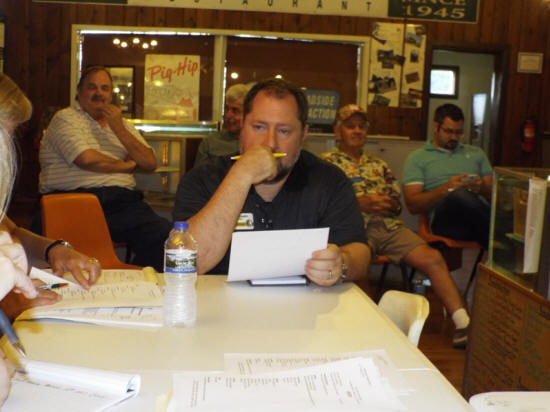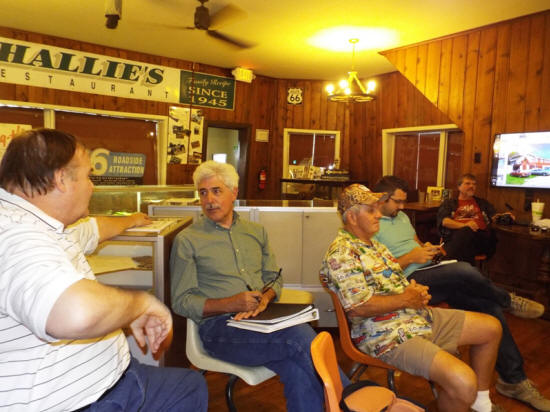|
Tourism Bureau hears update on
Tropics sign restoration
Discussions move into supporting physical
attractions
 Send a link to a friend
Send a link to a friend
 [June 22, 2017]
LINCOLN
- On Monday, June 19th, the Logan County Tourism Bureau met
for its monthly meeting at the Mill on Route 66. Prior to the
meeting, the Mill was opened for board members to come in and take a
tour if they wished. As the meeting convened, all board members were
present, which included Gale Apel-Sasse, Kevin Bateman, Emily
Davenport, Cindy Fleshman, Kathy Horn, Steve Parrott, Shawn Taylor
and Marilyn Wheat. [June 22, 2017]
LINCOLN
- On Monday, June 19th, the Logan County Tourism Bureau met
for its monthly meeting at the Mill on Route 66. Prior to the
meeting, the Mill was opened for board members to come in and take a
tour if they wished. As the meeting convened, all board members were
present, which included Gale Apel-Sasse, Kevin Bateman, Emily
Davenport, Cindy Fleshman, Kathy Horn, Steve Parrott, Shawn Taylor
and Marilyn Wheat.
The board learned that Kenna Shaffer had resigned from the board.
Shaffer was the hotel/motel representative on the board. Her
resignation came about because she is no longer working for the Best
Western in Lincoln.

Also on hand at the opening of the meeting was Tom
McLaughlin. At that time McLaughlin was a candidate for the board.
Later in the evening at the voting session of the Lincoln City
Council, he was approved as a board member replacing Ron Keller and
representing Lincoln College and Lincoln Heritage Museum.

Left to right:
Bill Kelly, Bill Thomas, Bob Wilmert, David Doolin, Geoff Ladd
Others on hand for the meeting for the bureau were Interim Director
Cris Wibben and Administrative Assistant Megan Gleason; guests Geoff
Ladd, Bob and Barb Wilmert for the Mill; Bill Kelly of the Route 66
Byways; Bill Thomas representing the Tropic sign restoration
committee; and David Doolin, website developer and owner of the
Explore Logan County website.

After being called to order by Sasse, who is currently the acting
board president, Ladd introduced the guests in the room, and
welcomed the board members to the Mill.
Tropics Sign
Bill Thomas was the first to speak, sharing information about the
fundraising efforts for the Tropics sign restoration project. To
date, the committee has “in-hand” $47,816 with a goal of raising
$70,000. Thomas was asked if that included any outstanding grants.
He responded that there are grants yet outstanding that will be
added to that total if awarded.
He specified that the committee has not heard from the Woods
Foundation about the application for $27,000. He said he believed
the Foundation should make a decision by the mid part of July.
Thomas said if the project does not receive the award, he will have
a discussion with the Foundation to determine why the grant
application fell short, will adjust as needed, and resubmit the
application with the hopes of then receiving the grant.
Thomas said that the committee is moving forward with the
restoration, and that next week on Tuesday, Ace Sign Company of
Springfield will come to Lincoln and retrieve the sign. It will be
taken back to Springfield where work will begin.
Thomas also talked about the ownership of the sign. If the
restoration project is completed successfully, the Logan County
Tourism Bureau will own the sign, but the city of Lincoln will be
responsible for it. While it now looks like the restoration project
will be completed, if it is not for some reason, ownership of the
sign would then revert back to the Goodrich’s.
Thomas, Kelly and Ladd talk about supporting ‘brick & mortar”
attractions
Thomas also suggested that the board give consideration to making
grants available for preservation of tourist attractions in the
county.
[to top of second column] |

He noted that the bureau currently uses all its cash resources
for marketing grants, but capital grants are needed in order to maintain and
develop tourist attractions in the county. He said that it is getting harder and
harder to find grants for capital improvements, and the bureau could become a
new resource.
Sasse asked for clarification that Thomas was referring to supporting the “brick
and mortar” or physical attraction. Thomas said he was. That money is needed to
keep attractions in good repair, and also to seek out new attractions and make
them into desirable places for tourists to visit. He said that it is a proven
fact that good tourism promotes economic development.
Wibben said that under the terms of the state grant funds, money
cannot be spent for capital improvements. However, money could be designated
from the hotel/motel tax for capital projects.

Later in the evening Kelly and Ladd would both address this same
topic. Ladd would point out that in Pontiac, the city tourism bureau pays for
part-time staff at the Route 66 museums in town and pays the utilities on the
various sites. In Litchfield, the annual contributions are made for maintaining
attractions, and an annual grant is awarded in Bloomington Normal for the same
purpose. Ladd said this shows there is a precedent for supporting physical
attractions in addition to promoting them through marketing.
Ladd was asked about the tax revenues in those communities. He said that in
Pontiac the hotel/motel tax revenue is less than the city of Lincoln. He noted
the small community has fewer motels than Lincoln, thus less income from the
tax.
Kelly also supported the suggestion from Thomas saying that tourism does drive
economic development and brings income into communities. He said that Abraham
Lincoln and Route 66 are two big draws state-wide for tourism, and Logan County
has both. In the 2014 and 2015 tourism reports, it showed that Route 66 counties
do very well in attracting tourist. He also noted that at the last report, Logan
County ranked fifth out of 102 counties for tourist traffic, excluding Chicago.
He commented, “As we approach the anniversary of Route 66, the world is going to
show up here. It is in tourism's best interest to invest in Route 66.”
Parrott asked of Thomas just how many brick and mortar locations there were in
the county, both those established and those that need to be established for
tourism.
Thomas said that was a tough question to answer. He said, “That’s an excellent
question, because, even though I am a preservationist at heart, hard core, in
this instance, you have to look at it strategically as to what to preserve that
is going to have a direct return of investment from tourists, not just
preservation for the sake of preservation, but preservation melded into a
strategic vision of using tourism for economic development.”
Parrott said he wondered how many buildings that would be, and Thomas said right
now he couldn’t answer that specific question, but that he had an approach for
identifying those key locations that would help spur tourism.

Ladd and Thomas also talked about using tourism dollars to match other grants
when needed. Thomas said if the bureau decided to move forward with this type of
support, it could also reach out to other funding sources for matching funds
partnerships. He mentioned specifically the Danner Trust in Mount Pulaski, who
has awarded dollars to several projects in the county.
It was noted by Ladd that the first National Park Grant the Mill received was a
few years ago for the restoration of the floors. In that project the Danner
Trust provided the matching grant funds required for the National Park Grant.
Thomas concluded by encouraging the board to strongly consider this suggestion.
He said the "key" first step would be to develop a strong policy and strategic
plan for establishing the grant program.
[Nila Smith] |